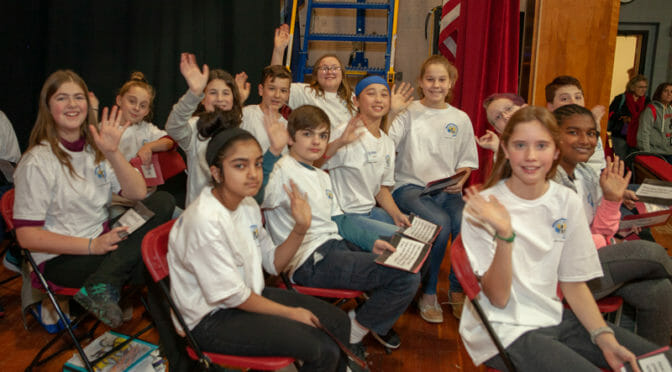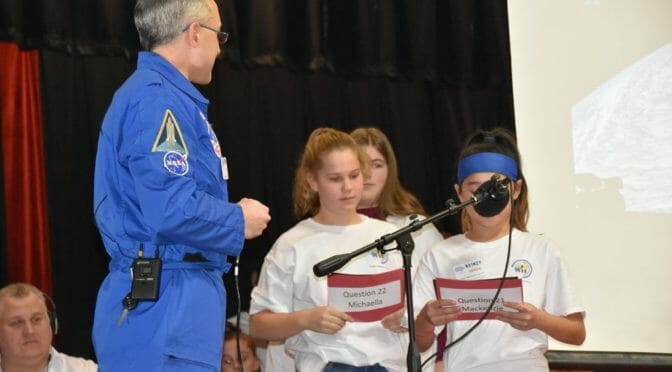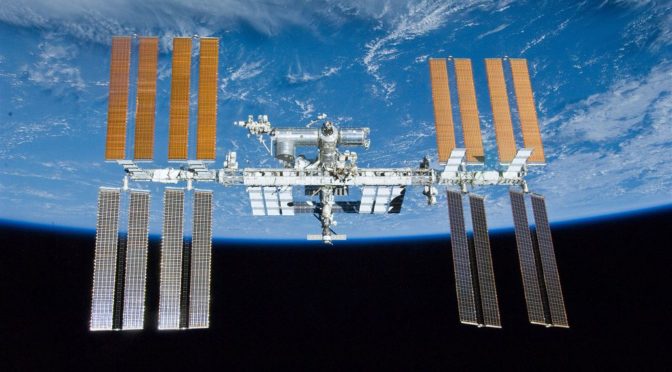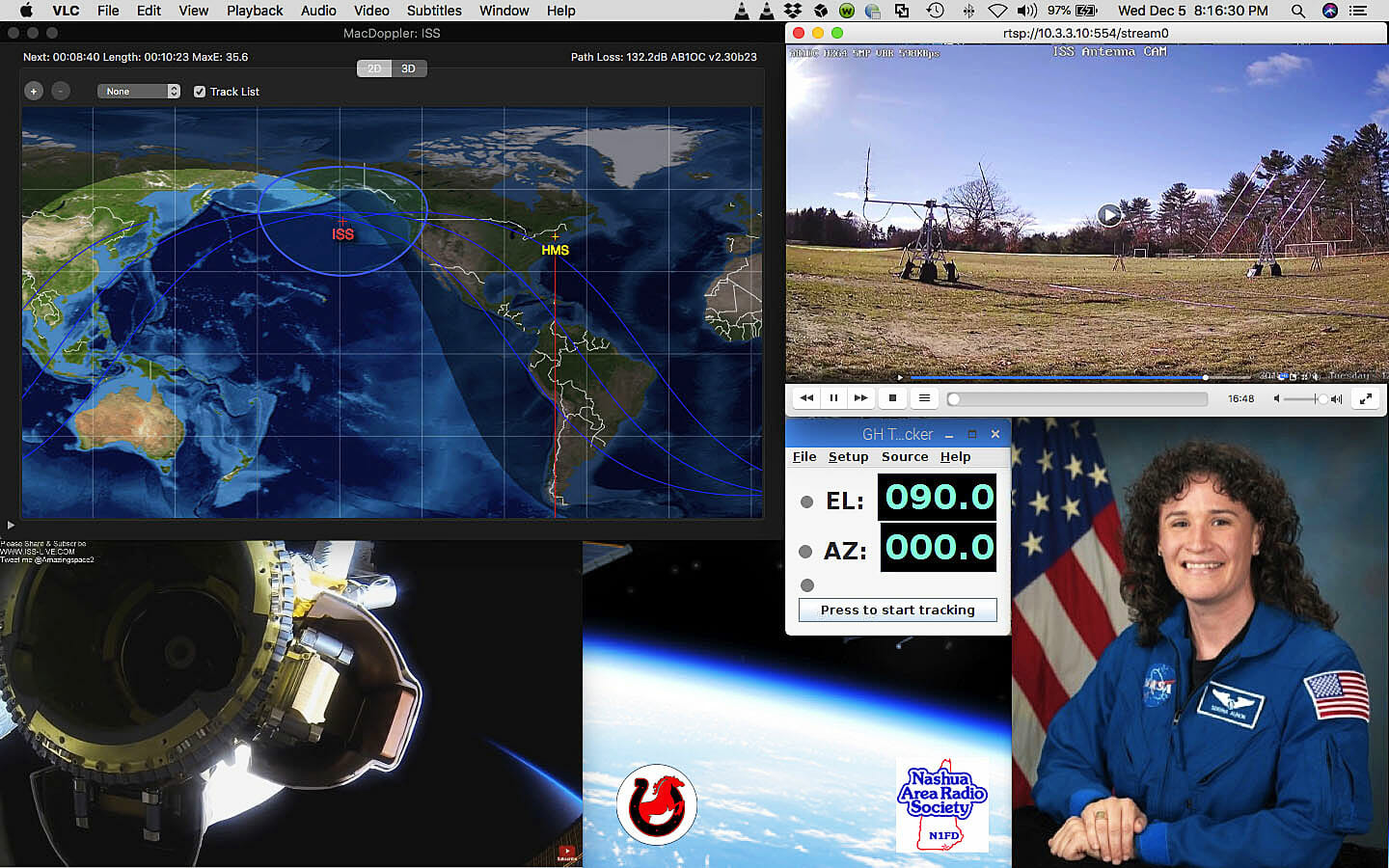A year and a half of work for only nine minutes. Not knowing the context or the situation, most would say that no matter what the nine minutes were for, it was not worth it. Others would cringe at the idea of having to work for so long to get so little. In this case, I think anyone that was part of the event would agree that the work and the time needed to achieve success was well worth it. The event that I am writing about is the Hudson Memorial School Contact with Serena Auñón-Chancellor on the International Space Station that occurred at 1:49 pm EST on Friday, December 7, 2018.
At 1:49 pm EST, when Fred Kemmerer (AB1OC) called NA1SS and the gymnasium full of students, staff, and guests heard Serena call back, the moment was exhilarating, amazing, thrilling, and more. Students and adults alike let out a roar of excitement that the contact had worked. At that moment they knew that they were about to get a rare opportunity that few schools had experienced. They were going to get to talk directly to an astronaut on the International Space Station. The loud outburst of excitement was followed by nine and a half minutes of something that does not occur in middle school very often. The students and adults in the room sat silent and on the edge of their seats as the selected student and Serena went back and forth through fourteen prepared questions. Toward the end of the time, the last student stepped to the microphone, thanked Serena and heard Serena thank the school in return for the amazing questions. Once again, the room erupted in excitement. The contact was a success.
So, what was all the work that I spoke about, one might ask. A year and a half prior to the contact, I emailed the Nashua Area Radio Society to see if there might be some interest in making such an event occur. I was greeted with the best partnership that Hudson Memorial has ever seen. Fred Kemmerer and the rest of the Nashua Area Radio Society stepped up to support this large undertaking. We worked together to complete the ARISS Proposal, which can be found at http://www.ariss.org/hosting-an-ariss-contact-in-the-us.html . The form asked about our preparedness to host the contact technically and educationally. On the school side, we shared all of the space and radio communication education opportunities that Hudson Memorial School provided our students and would provide our students, should we be granted a contact. The opportunities that we already offered to our students were an in-depth space science curriculum in sixth grade, education about how waves work in both 6th and 8th grade, a 7th grade science fiction unit that had students talking to NASA scientists via Skype, Astronomy Nights, STEM nights, use of NASA statistics in the mathematics classroom, and a new Project Lead the Way Pre-Engineering program that asked students to find solutions to those that might be found on the ISS. The items that we proposed to add to enhance the radio and space curriculums at Hudson Memorial School included having students participate in a High Altitude Balloon curriculum, Radio Licensing classes, and adding activities where students could try out amateur radio opportunities. All of which, we were able to provide for students in the past school year.
In January, we learned that we were selected to host a contact. Excitement levels were raised for teachers at the school and members of the club alike. Everyone stepped up and began preparations, but there was a whole lot of waiting to find out when the actual date would occur. In the meantime, there were several important steps that needed to be received from the school. In October, the school began working on student questions and their story. The story basically gave ARISS information about Hudson Memorial School that would be used in their official press release once the contact was secured. The story explained the population make-up of the school and its goals for educating the students. The school also worked on the official press release to be sent to media outlets when the contact time was finalized. Students in grades 5-8 were offered the opportunity to submit questions through various classes. By the due date, there were over 600 questions submitted by students for the contact. Those questions were combed through by a group of HMS teachers to find the twenty-two questions that would be submitted to ARISS for the contact.
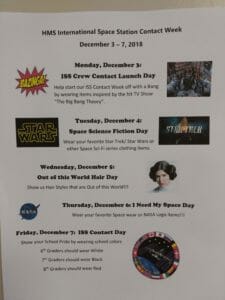
In addition to all of the work required by ARISS, I was able to arrange for an International Space Station Contact celebration week for the students at HMS. Since this was such a huge event, it was important to make it stretch for more than just one day. The week included themes for each of the 5 days in the week of December 3 – 7. Monday was ISS Crew Contact Launch Day. Students were asked to wear any items that connected to the TV show “The Big Bang Theory” so we could start our celebration off with a bang. It also was exciting that it happened to be the day that three additional astronauts launched to go to the ISS. Tuesday was Space Science Fiction Day. Students and staff wore items with Star Wars, Star Trek or other science fiction shows and movies. Wednesday was Out of This World Hair Day. Students came up with some interesting hair for the day. Thursday was Space and NASA clothing item day. Students showed off items of clothing with NASA logos. The week was wrapped up with a school color day. Kids wore red, white, and black to show their school pride. The theme days were just a part of the excitement. Each morning during the announcement the students learned facts about the ISS. Staff also played different music with space themes in the middle of the day. The songs included David Bowie’s “A Space Oddity,” Elton John’s “Rocket Man,” and Europe’s “The Final Countdown.”
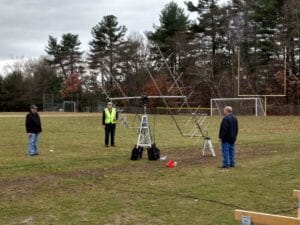
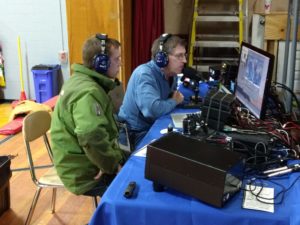
Throughout the week, the Nashua Area Radio Society began setting up and testing the equipment. On Monday of the contact week, the antennas and radio equipment were installed on the field and on the stage. Students and staff passing through the gymnasium were able to watch as the club meticulously made sure everything was working properly. Tuesday, members of the club came back to test the equipment by making contacts on various amateur satellites. On Wednesday, Fred Kemmerer, Dave Merchant, and I came back to Hudson Memorial School at 8 pm at night to equalize the gymnasium for sound quality. Throughout the week, I became accustomed to properly rolling and unrolling coax and hardline cables numerous times. I learned about various radio settings and the fading that might occur during the contact. The week of set-up was both tiring and educational for a new ham like myself. This week alone showed the devotion and dedication that the members of the Nashua Area Radio Society has for educating youngsters in hopes of inspiring students to pursue STEM education opportunities.
All of these items and more occurred over the course of a year and a half to ensure that the nine and a half minutes of contact we were granted by ARISS with the International Space Station would go off flawlessly. All of the countless hours of late night conference calls, practice at area Ham Festivals with the satellite stations, the work on space and radio curriculum for students, and sleepless nights became worth it when Serena’s voice could be heard by the over 800 students and 200 guests that were sitting in the HMS auditorium and over 600 students watching the Nashua Area Radio Society live stream. The fatigue and struggles to get to this point no longer mattered because all of us involved in this process knew that what we had done would most likely be a moment that everyone in the room would remember and talk about for the rest of their lives. We hoped that at that moment, our hard work would inspire some student watching the contact to pursue a STEM career that would change the world. It was at that moment that we knew no amount of work would have stopped us from getting to this nine and a half minutes because we gained as much, if not more, from this experience as the students.
For this nine and a half minutes, we went on a year and a half long journey that would not have been possible without the teachers of Hudson Memorial School; HMS Team three teachers Adam Goldstein, Rachel Scanzani, and Kathleen LeLievre; HMS Principal Keith Bowen; and the members of the Nashua Area Radio Society. A deep heartfelt thank you to Fred and Anita Kemmerer, Burns Fisher, Dave Merchant and all of the members who donated their time to successful set-up, operation, and breakdown of all the equipment required to make this contact a success.
Dan, AC1EN

